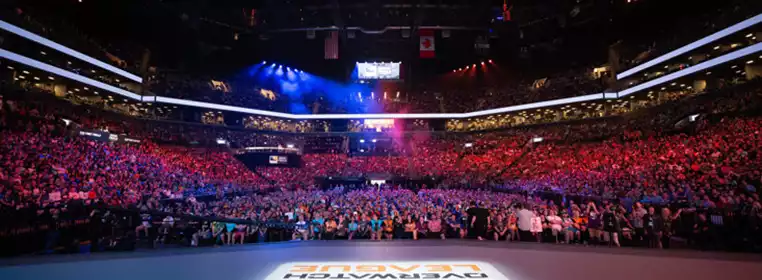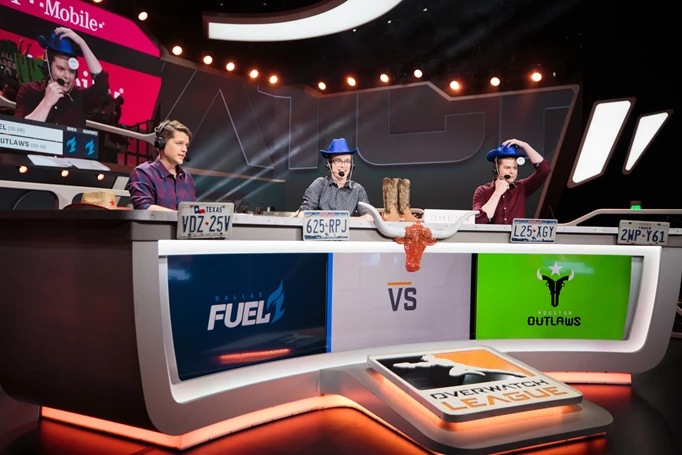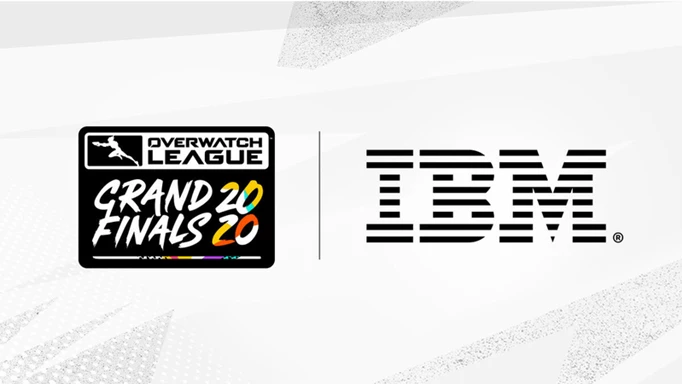Jon Spector On The Changes Coming To Overwatch League And Its Broadcast

The Overwatch League has announced a wide variety of changes and improvements to its broadcast and its competitive structure going into the 2021 season. From scheduling the season start date to April, announcing international online tournaments of which four will be held throughout the season, upgrades to the broadcast experience and more, GGRecon sat down with Overwatch Esports Vice President Jon Spector to discuss the decisions the League has made. For an elevator explanation of the most important changes, check out our video summary here.
Competitive format changes
The Overwatch League has once again been split into two regions; this time called West and East with a split of 12 teams playing in North America and eight teams playing in Asia. On top of the already announced franchise Philadelphia Fusion, the New York Excelsior and the Los Angeles Valiant will play in the Eastern region alongside the Asian franchises Chengdu Hunters, Hangzhou Spark, Guangzhou Charge, Shanghai Dragons, and Seoul Dynasty.
The Overwatch League has adjusted the amount of regular-season events down to only 16 matches per team, continuing the reduction in the number of games that teams had to play over the seasons from initially 40 in season 1, 28 in season 2, and 21 in season 3. Unlike last season, not all teams will make it into each tournament. Instead, teams will have to play four regular-season matches to qualify, and those with the best win record will get to participate in the bracket stages. The amount of teams which will make it into the knockout stages of each tournament cycle has not been shared yet.
According to Jon Spector, the amount of regular-season matches results from the League’s search for the optimal amount of matches, utilising data from past seasons to analyse their implications of the expected impact on tournament qualification through differences in strength of schedule. “We went back through the data from last season and previous years and ran some simulations on ‘if you want to get accurate seedings into a tournament, how many matches would you have played to do it?’ Because of COVID, we had a natural experiment last year” shared Spector, elaborating that “for three matches, there’s still a good degree of randomness in terms of strength of schedule really mattering. [...] When we looked at the four-match seeding results it super closely paralleled what our internal ELO model said the ranking should be.”
Tournaments move into focus, becoming international
Perhaps the biggest surprise of the announcements comes at the hand of tournaments becoming internationally online competitions instead of staying intra-regionally like the regular season. According to Jon Spector, the decision had been made to allow the best teams in the world to compete against one another on a more regular basis, while taking into account the operational realities of running a league during a global pandemic.
“The driving operational constraint really is about servers and ping. [...] I now know way more about internet cable routing than I really ever wanted to in my life” Spector shared smiling. “Back in December we launched the minimum latency feature [...] on live Overwatch. If you want to do this yourself now, you can in custom game settings.” Blizzard Entertainment had already tried the feature at the Contenders Gauntlet, running player surveys afterwards asking competitors about the competitive experience. According to Spector, the general feedback was that most players felt issues were mostly popping up in latency ranges over 90 milliseconds of delay. With that approximate threshold in mind, the League set out to create operationally workable systems.
Barring further complications resulting from the global pandemic, one of the solutions the Overwatch League team feels confident about being able to deploy is to run international tournaments between Asian and North American teams, finding an interesting solution to the issue of ping.
He explained: “For tournaments, specifically [...] plan A for how we pull that off would be that you take the top couple of teams [from] North America that qualify and then have them actually travel to Hawaii which from an immigration and safety perspective works well because Hawaii requires the same visas as the rest of the US obviously and then from a server perspective - again my odd knowledge about how the internet works now - we can directly route traffic via an undersea cable from players competing in Hawaii to a Tokio server and that latency in our early testing is sorta right in that 90 [millisecond] threshold.”
Spector explained that the logistical scope of only having to send the qualified North American teams over to Hawaii for a tournament weekend made more sense than having to plan the entire season around this strategy.
Another issue the League had to solve is for the two European franchises to remain on their home continent while ensuring that competitive play was going to be playable within the outlined 90-millisecond threshold. “When you look at Europe connecting to America, the best server location that we can facilitate is going to be on the East coast of the US somewhere. It varies depending on where in Europe you are connecting to from that but a lot of our testing from London and Paris for example pegs that at about 90 milliseconds,” the Spector shared.
A positive byproduct of their research into latency was the improvement of coast to coast ping for teams in North America. “We have the ability to deploy a server smack in the middle of the country next year,” said Spector, continuing that “You can run those matches at 60 or 70 ping whereas last year, if the Gladiators were playing the Fusion, the Gladiators were at 80-something typically.”
In regards to how the tournaments would influence playoffs qualification, the Vice President of Overwatch Esports shared that the League has the intention to design systems which reward teams for doing well in the regular-season tournaments, though a decision in which way this would be achieved had not been decided on just yet. Last year, the Overwatch League had installed an incentive system that saw deep runs in the three respective tournaments rewarded with bonus victories towards the regular season score which became important towards the seeding into the season’s playoff bracket.

 Click to enlarge
Click to enlargeWhat will change about the broadcast?
Changes, improvements, and additions are also coming to the broadcast experience. During the season’s playoffs, the league had introduced a virtual arena to the broadcast, including a virtual desk for analysts to discuss at. “Bringing back a virtual set environment is a real priority and something I think we are going to be looking to do,” Spector affirmed.
Moreover, the League is looking to improve its broadcast experience, working on several improvements. Once again already kicked off last season, the League is looking to involve players more in the broadcast in season 4. Bringing back players for post-match interviews became possible later on in season 3 when technical limitations had been bested. In season 4, the League wants to go further, incorporating faces and reactions of players during the live matches, possibly in replays or otherwise.
On the platform side of things, the Overwatch League has been actively working with YouTube to improve the broadcast experience from a technical perspective while figuring out content strategies and discoverability. A feature Jon Spector is particularly excited about is the improvement of the stream’s quality when broadcasting Overwatch gameplay.
He said: “There is also then a host of improvements we are looking to do with YouTube as we head into the second year of our partnership with them. The one that I’m most excited about is just going to be upping the actual stream quality, and that’s something we’ve been working hard at with them and now are confident that we are going to be able to deliver for next year. I think watching Overwatch as we tested that a higher stream quality actually makes a pretty big difference from my perspective. It’s easier to follow the action and is just a better fan experience.”
The team is also looking to improve the reward system while trying to bring more value to the viewer when watching the Overwatch League stream.
Slightly self-critical and reflective was Spector when talking about the type of content that the League had been pushing at the start of their time on YouTube. “One of the lessons learned from 2020 on YouTube - which sounds obvious in retrospect - but if you take content that performs well on other platforms and kind of assume that it would do the same on YouTube without learning specifically about what does well in that environment than how to drive engagement on YouTube I think that’s a strategic miss.” The team had sat down with YouTube and had looked at what kind of content could be expected to perform better on the platform, making the strategic move towards more guide, tips, and tricks content while also having the added benefit of being a funnel of general Overwatch player leading them to the esports side of things.
Other than the specific content that the League is looking to produce, the manner or tone with which content is framed is arguably more important. Realising the opportunity given the talent on the broadcasting team, Spector says that the League has realised their opportunity. “We have incredibly entertaining casters and folks on the desk. A lot of our players are the same. Bringing those personalities to the fore and having fun with our fans and doing more to acknowledge, lean into, and create community memes and celebrate all of the fun that people are having I think is a better tone for us to take overall. You’ll continue to see us push into that direction.”

 Click to enlarge
Click to enlargeThe value that the IBM deal brings to the table
In October, the Overwatch League announced a partnership deal with the technology and consultancy giant IBM which was said to “develop technology solutions leveraging IBM’s expertise in natural language processing and machine learning to improve the league’s rankings system, and utilize IBM’s Watson AI capabilities to create live and in-broadcast predictive analysis” according to Blizzard Entertainment’s press release. With the specific contribution likely quite nebulous in fan’s minds, GGRecon asked Jon Spector in which concrete ways the deal was going to impact the broadcast experience.
He said: “The focus for the start of the 2021 season is really going to be around levelling up our use of stats through IBM. [...] If you look at what we did in 2020, a lot of our stats were showing head to head comparisons on the broadcast and then publishing the DIY stuff through our stats lab data product on the website which I think is a huge step in the right direction to arm all our stats nerds with [..] everything they might ever want. I think there is a better fan-facing product that is dissecting all of that stat information and presenting it in a way where you could start to answer 'Who is the best at Overwatch?' or 'Why is this team the best?' through stat driven ways and a lot of initial focus with IBM has been on that type of work.”
Throughout the last season, the Overwatch League had presented statistics of players either giving numerical values of a player’s contribution in damage, elimination, assist, and more without context, or put them into side by side comparisons against their direct opponents. These graphics suffered from additional lack of context of those numbers and didn’t always accurately portray their contribution to the outcome of a match.
Overall, the Overwatch League presented an overarching strategy towards the improvement of the broadcast coming into its fourth season, navigating the circumstances of the global pandemic while trying to adapt the broadcast more to its target audience. Competitive integrity, especially in regards to latency related issues, seems to have been strongly considered and extensive effort appears to have gone into finding workable solutions for the season. With the general outline of the season now known, the League will have to figure out the details in terms of its more granular competitive format such as the incorporation of Hero pools, and the specific scheduling of matches for each respective team.
GGRecon will keep you up to date on all developments in the Overwatch League. Stay tuned with our socials by checking out our social channels here: Twitter | Facebook | Discord
Images via Blizzard Entertainment